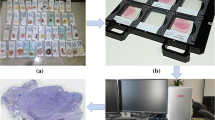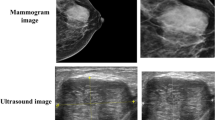Abstract
Shape descriptors have been identified as important features in distinguishing malignant masses from benign masses. Thus, an effective morphological irregularity measure could provide a helpful reference to indicate the likelihood of malignancy of breast masses. In this paper, a new Fourier-Transform-based measure of irregularity—Fourier Irregularity Index (F 2), is proposed to provide reliable malignant/benign tumor/mass classification. The proposed measure has been evaluated on 418 breast masses, including 190 malignant masses and 218 benign lesions identified by radiologists on film mammograms. The results show the proposed measure has better performance than other approaches, such as Compactness Index (CI), Fractal Dimension (FD) and the Fourier-descriptor-based shape Factor (FF). Furthermore, these mentioned measures are paired to investigate the possibility of performance improvement. The results showed the combination of F 2 and CI further enhances the performance in indicating the likelihood of malignancy of breast masses.




Similar content being viewed by others
Notes
Our implementation is based on package PyRadbas: http://cybercase.github.io/pyradbas/
References
Alto H, Rangayyan RM, Desautels JEL (2005) Content-based retrieval and analysis of mammographic masses. J Electron Imaging 14:023016–023016
D’Orsi C, Bassett LW, Berg W, Feig S, Jackson V, Kopans D (2003) Breast imaging reporting and data system: ACR BI-RADS-mammography. American College of Radiology (ACR), Reston
Davies D, Dance D (1990) Automatic computer detection of clustered calcifications in digital mammograms. Phys Med Biol 35:1111
Dey P, Mohanty SK (2003) Fractal dimensions of breast lesions on cytology smears. Diagn Cytopathol 29:85–86
Freeman H (1961) On the encoding of arbitrary geometric configurations. IRE Trans Electron Comput EC-10:260–268
Guo Q, Ruiz V, Shao J, Guo F (2005) A novel approach to mass abnormality detection in mammographic images. In: Proceedings of the IASTED International Conference on Biomedical Engineering, pp 180–185
Heath M, Bowyer K, Kopans D, Moore R, Kegelmeyer WP (2001) The digital database for screening mammography. In: Proceedings of the Fifth International Workshop on Digital Mammography, pp 212–218
Kilday J, Palmieri F, Fox MD (1993) Classifying mammographic lesions using computerized image analysis. IEEE Trans Med Imaging 12:664–669
Kwon K-C, Lim Y-T, Kim C-H, Kim N, Park C, Yoo K-H, Son S-H, Jeon S-I (2012) Microwave tomography analysis system for breast tumor detection. J Med Syst 36:1757–1767
Lee TK, McLean DI, Atkins MS (2003) Irregularity index: a new border irregularity measure for cutaneous melanocytic lesions. Med Image Anal 7:47–64
Liang S, Rangaraj MR, Desautels J (1993) Detection and classification of mammographic calcifications. Int J Pattern Recognit Artif Intell 7:1403–1416
Liberman L, Abramson AF, Squires FB, Glassman J, Morris E, Dershaw D (1998) The breast imaging reporting and data system: positive predictive value of mammographic features and final assessment categories. Am J Roentgenol 171:35–40
Matsubara T, Fujita H, Kasai S, Goto M, Tani Y, Hara T, Endo T (1997) Development of new schemes for detection and analysis of mammographic masses, pp 63–66
Peitgen HO, Jürgens H, Saupe D (2004) Chaos and fractals: new frontiers of science. Springer Verlag
Pohlman S, Powell KA, Obuchowski NA, Chilcote WA, Grundfest-Broniatowski S (1996) Quantitative classification of breast tumors in digitized mammograms. Med Phys 23:1337
Rangayyan RM, El-Faramawy N, Desautels JEL, Alim OA (1997) Measures of acutance and shape for classification of breast tumors. IEEE Trans Med Imaging 16:799–810
Rangayyan RM, Mudigonda NR, Desautels JEL (2000) Boundary modelling and shape analysis methods for classification of mammographic masses. Med Biol Eng Comput 38:487–496
Rangayyan RM, Nguyen TM (2007) Fractal analysis of contours of breast masses in mammograms. J Digit Imaging 20:223–237
Salzberg S (1997) On comparing classifiers: pitfalls to avoid and a recommended approach. Data Min Knowl Disc 1:317–328
Shen L, Rangayyan RM, Desautels JEL (1994) Application of shape-analysis to mammographic calcifications. IEEE Trans Med Imaging 13:263–274
Spiesberger W (1979) Mammogram inspection by computer. IEEE Trans Biomed Eng BME-26(4):213–219
Wee WG, Moskowitz M, Chang NC, Ting YC, Pemmeraju S (1975) Evaluation of mammographic calcifications using a computer program. Radiology 116:717–720
Wei Y, Su Z, Yazhu C, Yaqing C, Wenying L, Hongtao L (2008) Effective shape measures in malignant risk assessment for breast tumor on sonography. In: International Multisymposiums on Computer and Computational Sciences. IMSCCS ‘08, pp 51–56
Wikipedia (2012) Fourier series. Available: http://en.wikipedia.org/wiki/Fourier_series
Xiangyang X, ShengZhou X, Lianghai J, Shenyi Z (2010) Using PSO to improve dynamic programming based algorithm for breast mass segmentation. In: 2010 I.E. Fifth International Conference on Bio-Inspired Computing: Theories and Applications (BIC-TA), pp 485–488
Zabrodsky H, Peleg S, Avnir D (1995) Symmetry as a continuous feature. IEEE Trans Pattern Anal Mach Intell 17:1154–1166
Zhang G, Shin S, Wang W, Li Z, Choi H. A new Fourier-based approach to measure irregularity of breast masses in mammograms. In Proceedings of the 2012 ACM Research in Applied Computation Symposium (RACS ‘12). ACM, New York, NY, USA, pp 153–157
Zhang G, Wang W, Moon J, Pack JK, Jeon SI. A review of breast tissue classification in mammograms. In: Proceedings of the 2011 ACM Symposium on Research in Applied Computation (RACS ‘11). ACM, New York, NY, USA, pp 232–237
Author information
Authors and Affiliations
Corresponding author
Additional information
This research was funded by the MSIP (Ministry of Science, ICT & Future Planning), Korea in the ICT R&D Program 2013.
Rights and permissions
About this article
Cite this article
Zhang, G., Wang, W., Shin, S. et al. Fourier irregularity index: A new approach to measure tumor mass irregularity in breast mammogram images. Multimed Tools Appl 74, 3783–3798 (2015). https://doi.org/10.1007/s11042-013-1799-8
Published:
Issue Date:
DOI: https://doi.org/10.1007/s11042-013-1799-8




